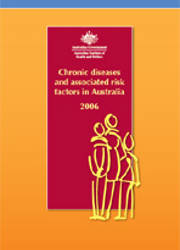Summary
This report
In 2002, the Australian Institute of Health and Welfare (AIHW) published Chronic diseases and associated risk factors in Australia, 2001. Building on this foundation, this new report presents updated statistics on chronic diseases and their associated risk factors in Australia. It focuses on patterns of disease across the age groups, the prevalence of risk factors and their trends, the impact of chronic diseases on health services in Australia, and differences in chronic diseases and their risk factors across geographical areas, socioeconomic status and Indigenous status.
Main findings
- Chronic diseases are common: in 2004–05, 77% of Australians had at least one long term condition; common were asthma (10.0% of the total population), osteoarthritis (7.9%), depression (5.3%) and diabetes (3.5%).
- Chronic diseases can be a problem at all ages: almost 10% of children 0–14 years had three or more long-term conditions; this figure increased to more than 80% for those aged 65 years and over.
- Many people are at risk of developing chronic diseases: for example, 54% of adult Australians are either overweight or obese.
- Some people are affected much more than others: for example, compared with other Australians,Aboriginal and Torres Strait Islander persons have higher mortality from diabetes (14 times higher), chronic kidney disease (8 times) and heart disease (5 times).
- Chronic diseases are a drain on the health system: in 2000–01 they accounted for nearly 70%of the total health expenditure that can be allocated to diseases.
Other findings
- In 2004 the major chronic diseases featured in this report (excluding depression) accounted for almost 50% of all deaths in Australia; the leading single cause of death was coronary heart disease (25,000), followed by stroke (12,000).
- These same diseases were implicated in 21.6% (or 1.5 million) of all hospital episodes of care in 2003–04; chronic kidney disease alone accounted for nearly 0.8 million episodes.
- Chronic diseases (including cancers) were responsible for more than 80%of the burden of disease and injury; the conditions reported here accounted for 42%of the total burden.
- Older people carry a relatively large share of coronary heart disease, stroke, diabetes, osteoarthritis and osteoporosis.
- The middle ages are not exempt, with large shares of depression, chronic kidney disease and coronary heart disease.
- More than 85% of adults are not consuming enough vegetables.
- One in two adults are not getting sufficient physical activity.
- Almost 50% of adults are not consuming enough fruit.
- Around 21% of adults smoke tobacco.
- Compared with major cities, regional areas of Australia experience higher prevalence of many of the risk factors for chronic disease, such as smoking (11% higher) and excess weight (7% higher); have higher death rates for coronary heart disease, chronic obstructive pulmonary disease, and diabetes; but have lower prevalence of asthma.
- Compared with areas of high socioeconomic status, the least advantaged areas of Australia have higher levels of smoking, physical inactivity and obesity; experience higher prevalence of diabetes, behavioural problems, asthma, heart disease and arthritis; and have higher mortality across most chronic conditions.
- Compared with other Australians,Aboriginal and Torres Strait Islander persons have higher prevalence of smoking, risky alcohol use and excess weight, and have higher rates of asthma, arthritis and diabetes.
Preliminary material (220KB PDF): Acknowledgements; Abbreviations
1. Introduction (274KB PDF)
- About this report
- Introducing chronic diseases
- Limitations of the data
2. The life course of chronic diseases
- Introduction
- Prevalence of chronic diseases across the life course
- Hospitalisations for major chronic diseases across the life course
- Mortality from chronic diseases across the life course
3. Risk factors across the life course (421KB PDF)
- Introduction
- Early life factors
- Risk factors in children and adolescents
- Risk factors in adults
- Multiple risk factors
4. Chronic diseases and health system resources (223KB PDF)
- Introduction
- General practitioner services
- Hospital services
- Other health services for people with chronic diseases
- Health system expenditure on chronic diseases
5. Chronic diseases and risk factors: regional, socioeconomic and Indigenous population groups (277KB PDF)
- Introduction
- Regional variations in chronic diseases and risk factors
- Socioeconomic variation in chronic diseases and risk factors
- Chronic diseases and risk factors among Indigenous Australians
Appendixes
Appendix 1: Methods
Appendix 2: Data sources
Appendix 3: Australian alcohol guidelines



